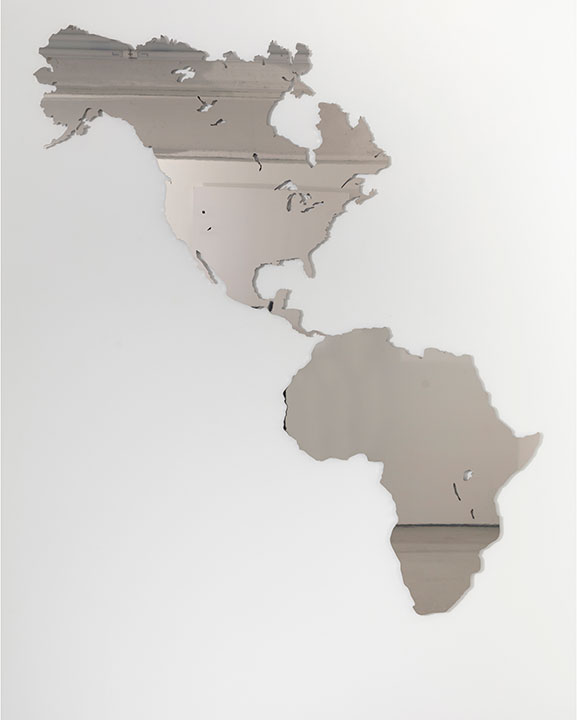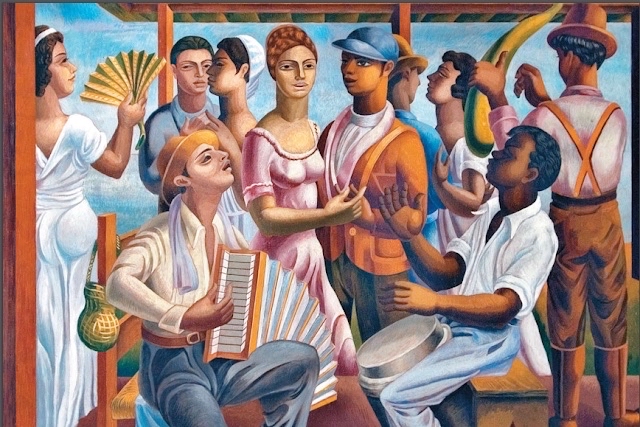All works of art pictured in this article are available for viewing in the exhibition.
On Sunday, April 10 of this year, Washington’s National Gallery of Art opened the touring Afro-Atlantic Histories exhibition to the viewing public. The six-part showing, which originally opened in 2018 as Histórias Afro-Atlânticas at Brazil’s Museu de Arte de São Paulo and Instituto Tomie Ohtake, features work from several renowned artists across disciplines, eras, and continents, including Pedro Figari, Faith Ringgold, and Kara Walker. Until Sunday, July 17, museumgoers have an opportunity to see four hundred years worth of art by and about the descendants of the Atlantic slave trade.
The distinction of “Afro-Atlantic,” or “Black Atlantic,” as coined by sociologist Paul Gilroy in his 1993 book of the same name, refers to the countless cultures and identities born from the intersection of members of the African diaspora and the many places that the slave trade forcibly sent them to. What is Afro-Atlantic, then, is at once African American, Afro-Brazilian, Afro-Jamaican, and so on. The “histories” mentioned in the exhibition’s title encompass not just historical documentation, but the vibrant and bountiful past and present of Afro-Atlantic cultural production, which ranges in the exhibition from painting, sculpture, and interdisciplinary art to religious artifacts.
Upon entry, visitors are met with the “Maps and Margins” section, which highlights the full scope and savagery of the slave trade. History and art collide to paint a chilling portrait of its foundations, processes, and influence,

beginning with Hank Willis Thomas’ “A Place to Call Home (Africa America Reflection),” a large wall sculpture depicting a geographic connection between North America and Africa. Both the room’s item curation and its layout facilitate visitors’ understanding of how the past informs the present, and the same is true of the neighboring “Enslavements and Emancipations.” In “Maps and Margins,” for example, James Phillips’ infamous eighteenth-century Description of a Slave Ship lays the groundwork for modern Brazilian sculptor José Alves de Olinda’s “Slave Ship” (called “Eshus’s Barge” in the Brazilian exhibition), a small wooden ship overrun by numerous Yoruba deities.
“Enslavements and Emancipations” features McPherson & Oliver’s “The Scourged Back,” one of the most recognizable depictions of the trade’s inhumanity, bookended by “Ex-Slave Gordon,” Arthur Jafa’s 2017 homage in sculpture to the photograph, and Eustáquio Neves’ 1995 “Untitled,” a photograph styled after the original, but the subject’s back is riddled with the word “Zumbi” instead of scars—the name of an iconic Brazilian revolutionary.
The movement from oppression to liberation remains a central theme throughout the rest of the exhibition. The third (and, to me, the most powerful) room, “Everyday Lives,” chronicles this movement in exhaustive detail.

Images of revolution, triumph, and regular, unperturbed life fill the space, poetically marking the transition of depictions of African and African-descended subjects from helpless to human. During the slave trade, European artists typically cast African subjects in the shades of servility and sorrow. The diverse visual narrative of “Everyday Lives” celebrates the death of the old and the birth of the new as each wall glows with battle-tested dignity. Imposing portraits of Joseph Cinqué and Toussaint Louverture by Nathaniel Jocelyn and Lou Stovall, respectively, support simpler scenes that the contributions of such revolutionaries made possible.
Much like the nearby National Museum of African American History and Culture, the journey through Afro-Atlantic Histories resembles a steady climb from dingy depths to the light of day, and “Everyday Lives” is the first glint of sun. The next two sections, “Rites and Rhythms” and “Portraits,” continue in similarly auspicious and distinguished veins. The former weds representations of song, dance, and sanctity in an impressively broad examination of cultural practices while the latter, in addition to housing the face of the exhibition’s advertisements, Zanele Muholi’s “Ntozakhe II, Parktown,” boasts equal parts magisterial and slice-of-life portraiture.

The journey ends with “Resistances and Activisms,” a brief but appropriate showcase of twentieth- and twenty-first century Afro-Atlantic visual protest. Faith Ringgold’s eye-catching narrative quilt “Who’s Afraid of Aunt Jemima?” adorns a wall opposite Titus Kaphar’s “Space to Forget,” a poignant meditation on the lasting effects of Black servitude. To leave, visitors must pass beneath David Hammons’ famous “African-American Flag,” which substitutes Old Glory’s red, white, and blue for the pan-African red, black, and green. David Smith for The Guardian notes the brilliance of the flag’s symbolic relation to the opening act, “A Place to Call Home.” The union of these “powerful bookends” underscores the very best of what Afro-Atlantic Histories has to offer: effective storytelling through excellent art.


